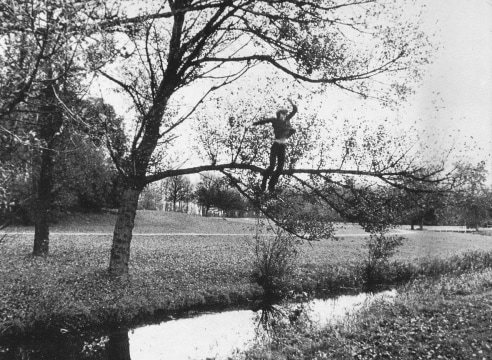
Anna Meliksetian and Michael Briggs are pleased to present Bas Jan Ader: Drifting Home, an exhibition of photo and video works curated by Pedro de Llano, focusing on the themes of domesticity and intimacy in the artist’s work. The exhibition marks the 40th anniversary of the artist’s passing and is the first exhibition of the artist’s work at Meliksetian | Briggs.
The reception of Bas Jan Ader’s oeuvre has been strongly conditioned by the mythology surrounding his disappearance, alone, in the Atlantic Ocean in 1975 in the midst of the second part of his project In Search of the Miraculous, a key piece in the history of Conceptual art, left tragically unfinished. Similarly, in previous works like Farewell to Faraway Friends and Untitled/Sweden, the lonely figure of Ader was situated by himself in the sublime landscape. In opposition to this type of work, romantic and contemplative, it is possible to locate another body of work in Ader’s career, in which notions such as intimacy and domestic space come to the forefront and have a prominent and essential role.
Upon returning to the US in 1963 from Holland, Ader carried with him the memories of the traumatic killing of his father during World War II, and the pressure from his mother to become a minister of the Dutch Reformed Church, following in his father’s footsteps. California was then a vast laboratory for the new suburban lifestyle, characteristic of post-war America. Ader settled in one of these new suburbs, in Claremont, shortly after getting married to Mary Sue Andersen in 1965. They lived surrounded by fields of lemon trees and middle-class families, until they moved back to the Los Angeles neighborhood of Los Feliz in 1972. During those seven years, Ader created several works in which the interior and the exterior of the house was the stage for tragicomic actions, wavering between nostalgia for the warmth and protection provided by a home such as The Artist as Consumer of Extreme Comfort (1968), and a certain tendency towards what could be called the “Caged Eagle” syndrome, like in Tea Party (1972).
In 1967, for example, Ader shows himself perched on the roof of the Claremont house, sitting on a chair, legs crossed, and detachedly smoking a cigar. This surrealist-like image was created as an illustration for the poster of his MFA thesis show. Its title, Implosion: The Artist Contemplating the Forces of Nature, addresses a paradox. On one hand, it speaks about an “implosion” an inward collapse, of a home perhaps, while, on the other, it seems to refer to the domestic environment as a shelter against the threat and unforeseeability of natural phenomena.
In other works, The Artist as a Consumer... and The Boy who fell over Niagara Falls (1972) adventures occur in the realm of literature as an antidote against boredom, a typical domestic malady. The artist shows himself as a reflexive and melancholic being, in the tradition of fellow Dutchman Rembrandt’s depiction of Jan Six (1647). 473 Reader’s Digests Digested (1970), on the contrary, is a project in which popular culture joins forces with the chaos and entropy of nature’s taking over the domestic space. All My Clothes (1970) is an absurdist and enigmatic image, in which the gesture of displaying his wardrobe, spread out on the roof of the suburban bungalow he shared with Mary Sue Andersen, can be read in different ways: Is it a Dadaist yard-sale? Or a reminiscence of the proverbial transparency of Dutch homes? Or perhaps it talks indirectly about the artist revealing himself naked?
In the territory of the traditional representations of the petite bourgeoisie home as a stable, predictable, and virtuous place, Ader chooses to introduce disturbing elements, either literally (nature) or symbolically (fiction). It is important to note thatthe artist always shows up alone in front of the camera (often operated by his wife or friends) – with only the company of his beloved dog, Lhoopie, as an indirect reference to the absent family. In these group of works spanning from 1967 to 1973, crucial in his maturation process as an artist, Bas Jan Ader’s journey through the spiritual vacuum of domestic space – a trip with deep roots in his family unconscious – seems as stormy, self-demanding, and impulsive on an emotional level, as the one in which his sailboat ended up drifting in the ocean.
Pedro de Llano, 2014